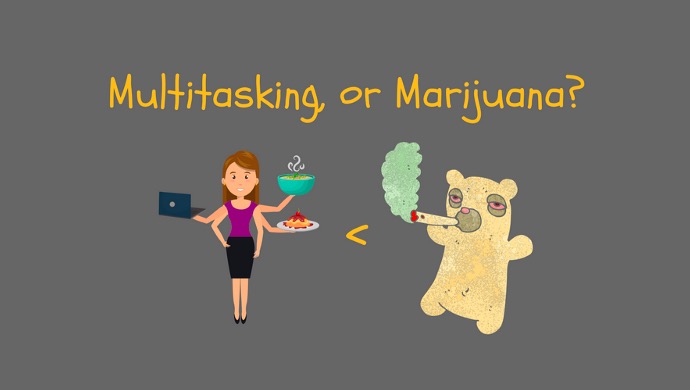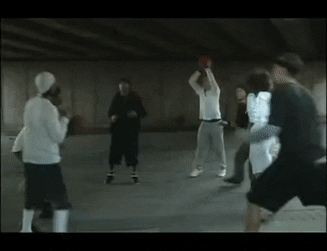Multitasking or marijuana? Is there a difference?

Take a look at this picture:

The character on the right is a bear. He also happens to be smoking marijuana. (Don’t ask me where he got it from. I don’t want to know.)The character on the right is a woman (I named her Sally). Other than the fact that she has five arms, Sally is your ordinary, everyday businesswoman.
Sally, like many other ordinary everyday businesswomen, also happens to be a hardcore multitasker. In our picture, we see her typing on her laptop, making some sort of dessert (flan, perhaps?) and balancing a scalding hot bowl of what looks like clam chowder on the palm of her hand.Now here’s the million-dollar question.Assuming Sally and the bear have the same level of intelligence (it’s a very smart bear), who will do better on a test of cognitive performance?
Also read: Want to get more done? Stop multitasking
In other words, if I care about mental performance, is it worse for me to multitask or to smoke pot?In his book The Organized Mind: Thinking Straight in the Age of Information Overload, New York Times bestselling author and neuroscientist Daniel Levitin argues that multitasking is even worse for us (cognitively… I don’t know about socially) than smoking pot:
“…[Marijuana’s] chief ingredient, cannabinol, activates dedicated cannabinol receptors in the brain and interferes profoundly with memory and with our ability to concentrate on several things at once. [Some guy named] Wilson showed that the cognitive losses from multitasking are even greater than the cognitive losses from pot smoking.”
To understand why multitasking is so bad, let’s take a short tour of human attention.
Balls and Switches
Think back and try to remember the first few hours of your day.
Can you remember what you ate for breakfast? What you drank? What about what time you brushed your teeth? I think most of us can remember these things.
Now let’s make the questions more difficult.Can you remember the number of tiles on your kitchen floor? What about the number of stairs you took down from your apartment or up to your office? Or the size and shape of the blades of grass sprouting from the cracks in your driveway?
Most of us (I sincerely hope) can’t.
In the Sherlock Holmes stories, Sherlock makes fun of Watson for not counting the number of steps (seventeen of them) up to their 221B Baker Street apartment. But Watson’s response is only natural: It’s not important to most people how many stairs they climb each day. So why pay attention?
Attention is a limited resource.
Monkey Business
When it comes to processing power, our brains are many, many times weaker than even the slowest supercomputer. We make up for this lack of power by being hightly selective about what we see.To demonstrate this, freshman psychology students are often shown the following video. Without cheating, try to count how many times the team in WHITE passes the basketball:

If you did the task seriously, you probably did not see the black bear (this time not smoking marijuana), that moonwalks across the playing field.
In fact, I find that I miss the bear now, even though I know it is there.Focus on one thing, and you stop seeing everything else.
Now You See It, Now You Don’t
Multitasking doesn’t just make you dumber, says Levitin. It’s also impossible.
Or, rather, it doesn’t work like most of us think it does.“That’s silly,” you might say. “I multitask all the time. I listen to my phone when I drive. I make spaghetti sauce as I boil noodles. I text with friends while at work.”
Yes, we can do multiple activities in the same span of time. But we never do these activities simultaneously, says Levitin:
“We all want to believe that we can do many things at once and that our attention is infinite, but this is a persistent myth. What we really do is shift our attention rapidly from task to task. Two bad things happen as a result: We don’t devote enough attention to any one thing, and we decrease the quality of attention applied to any task.”
To multitask, our attention has to shift rapidly back and forth, like the spotlight of a watchtower. This constant switching is quite taxing on the brain:
“Asking the brain to shift attention from one activity to another causes the prefrontal cortex and striatum to burn up oxygenated glucose, the same fuel they need to stay on task. And the kind of rapid, continual shifting we do with multitasking causes the brain to burn through fuel so quickly that we feel exhausted and disoriented after even a short time. We’ve literally depleted the nutrients in our brain.”
The bad news doesn’t stop there.
Multitasking releases cortisol, a stress hormone. Which means that juggling tasks makes us more anxious and less happy. It also seems to impede learning: watching TV and studying causes students to store information in the wrong part of their brains.
Multitasking hurts decision-making too. Task-switching forces us to make many micro-decisions, which means less “decision energy” for the important decisions in life:
“To make matters worse, lots of multitasking requires decision-making: Do I answer this text message or ignore it? How do I respond to this? How do I file this e-mail? Do I continue what I’m working on now or take a break? It turns out that decision-making is also very hard on your neural resources and that little decisions appear to take up as much energy as big ones. One of the first things we lose is impulse control. This rapidly spirals into a depleted state in which, after making lots of insignificant decisions, we can end up making truly bad decisions about something important.”
So, to sum all of this up, multitasking:
- Lowers the quality of your attention
- Makes you tire faster
- Makes you stressed and unhappy
- Makes you learn ineffectively
- Leads to more bad decisions now and in the future
Also read: 5 mistakes organisations make while implementing Agile
Ouch.
But if multitasking is so bad, why do we still do it?
Honey, It Feels So Good
We continue to multitask, says Levitin, for several reasons.One reason is because we’ve evolved to do so. In the jungle, the sight of red, edible fruit or a poisonous creature crawling through the underbrush was a life or death matter.This means that our brains are wired to respond to new and distracting information:
“The very brain region we need to rely on for staying on task is easily distracted by shiny new objects. In multitasking, we unknowingly enter an addiction loop as the brain’s novelty centers become rewarded for processing shiny new stimuli, to the detriment of our prefrontal cortex, which wants to stay on task and gain the rewards of sustained effort and attention.”
Another reason we like to multitask is because, in our heads, it feels like it works:
“You’d think people would realize they’re bad at multitasking and would quit. But a cognitive illusion sets in, fueled in part by a dopamine-adrenaline feedback loop, in which multitaskers think they are doing great.”
Part of the blame also lies on corporate culture, which often encourages employees to do counterproductive things:
“… workplaces are misguidedly encouraging workers to multitask … Many managers impose rules such as ‘You must answer e-mail within fifteen minutes’ or ‘You must keep a chat window open,’ but this means you’re stopping what you’re doing, fragmenting concentration, Balkanizing the vast resources of your prefrontal cortex, which has been honed over tens of thousands of years of evolution to stay on task.”
Now, with the above information in mind, we can ask a final question.If multitasking doesn’t work, what should we do about it?
What Instead?
There are too many ideas in Levitin’s book to share in detail here, but here are some examples of things Levitin suggests we can you can do to manage our multitasking, boost focus and creativity, and improve overall quality of life:
- Use a service like Boomerang to batch email-checking to once a day
- Offload to-do tasks from working memory to a set of index cards (to be processed later, GTD-style).
- Organize your schedule as a “metronome” that shifts between high-focus and high-daydreaming activities (say, computer work followed by a hot shower or walk in the woods). Daydreaming is restorative and necessary; multitasking is not.
- Store information outside of your brain and in the our environment using what he calls Gibsonian affordances.
- Set up different work spaces or computer environments for work and play.
- Block out all non-essentials (email, internet, phone calls, texts, etc.) for the most important hours of your day.
But, before you do all of this, the first step is to understand — multitasking doesn’t work.Now what will you do about it?
—-
Editor’s note: e27 publishes relevant guest contributions from the community. Share your honest opinions and expert knowledge by submitting your content here.
Join our e27 Telegram group here or our e27 contributor Facebook page here.
This article was originally published on Medium and was republished with permission. The article was first republished on e27, on February 26, 2018.
Featured Image Copyright: vadimgozhda / 123RF Stock Photo
The post Multitasking is like an addictive drug, and it is a big productivity killer appeared first on e27.